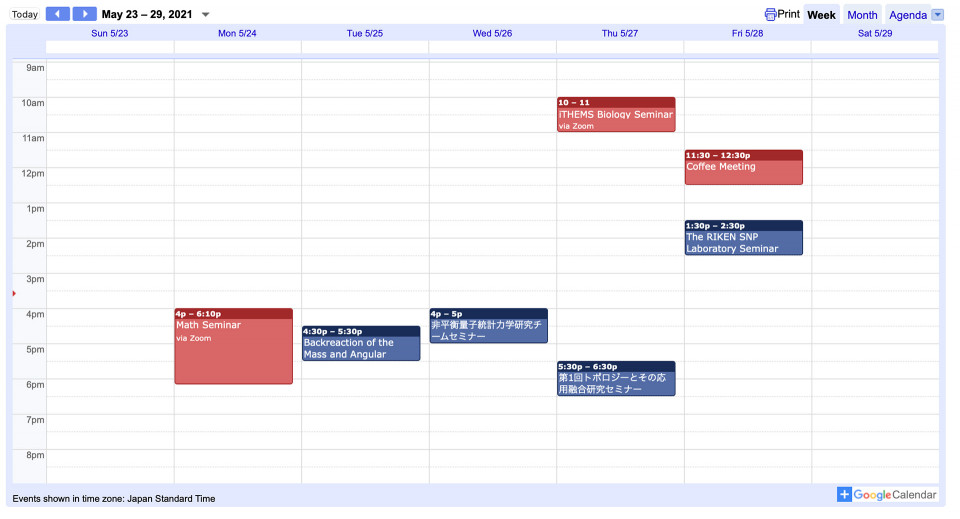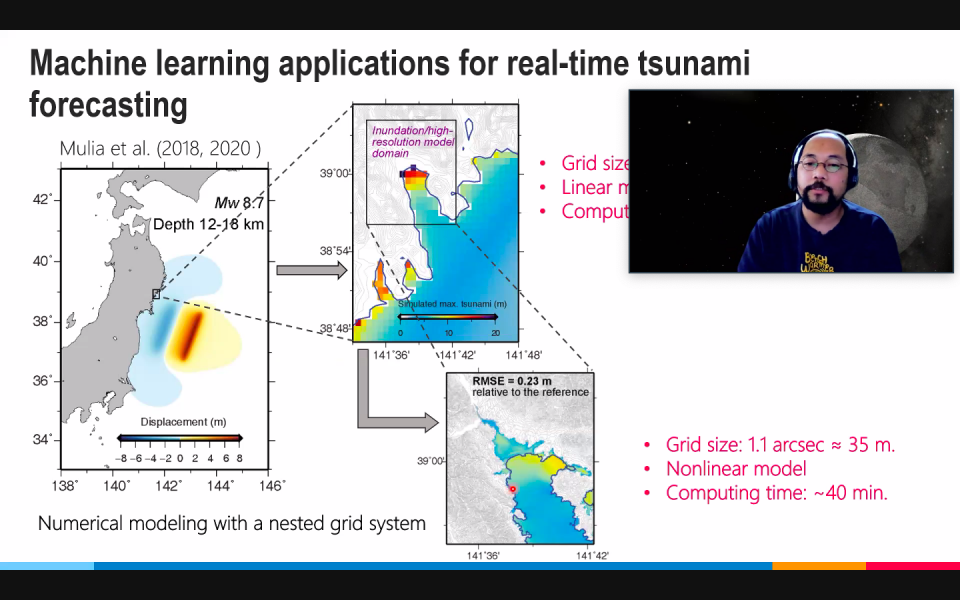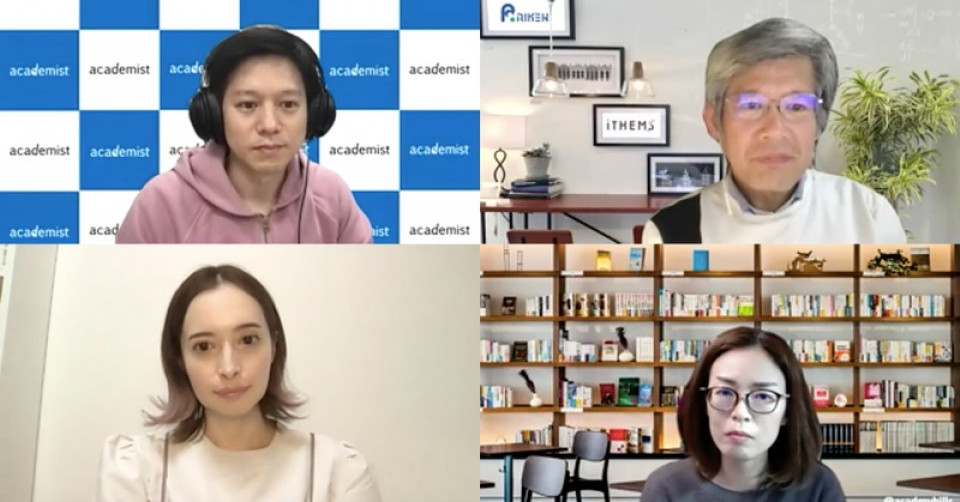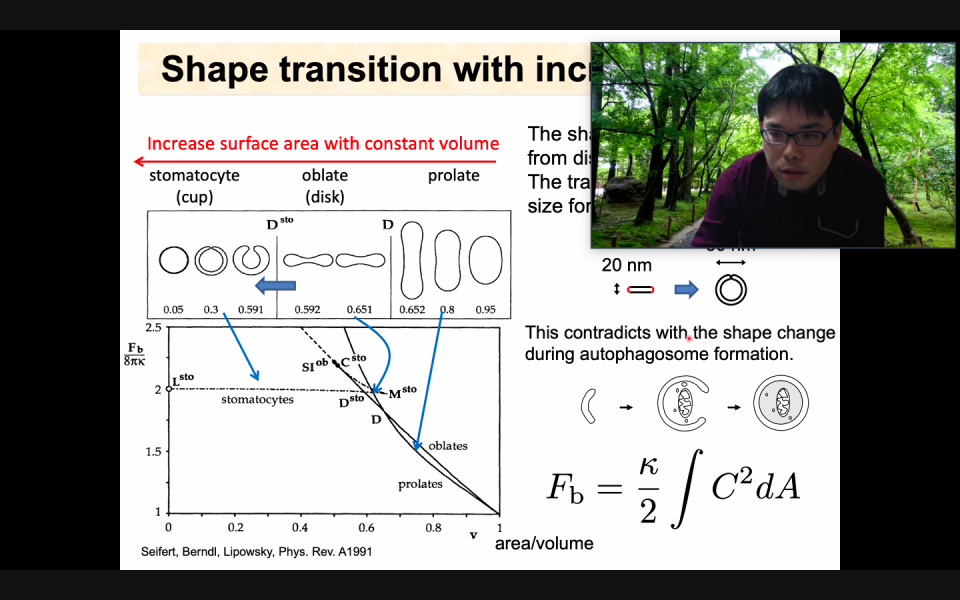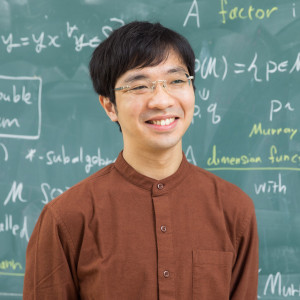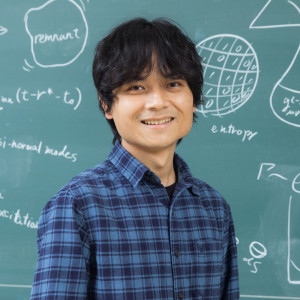Volume 151
Back to Newsletter List
Event Schedule
Events for the 5th week of May 2021
2021-05-20
Monday, May 24, 16:00- Math Seminar
Thursday, May 27, 10:00- iTHEMS Biology Seminar
Friday, May 28, 11:30- Coffee Meeting
Seminar Report
Math Seminar by Dr. Iyan Mulia on April 22, 2021
2021-05-20
On April 22, the iTHEMS Math seminar was held (Sorry for the delay of the report!).
This time, we invited Dr. Iyan Mulia from RIKEN Cluster for Pioneering Research, Prediction Science Laboratory.
The title of the talk was “Alternative tsunami observing and forecasting systems”.
The main topic of the talk was his work about how to catch and predict tsunami.
First, he proposed new approaches to construct tsunami observing systems. There exist various observing systems already, but they share a big problem that they are very expensive. Since observing systems need to be updated regularly, it is very important to reduce the cost. Iyan’s proposal is to make use of existing commercial vessels and airplanes. Since they already exist and form a dense network all over the world, it will suffice to let them observe the sea level altitude and transfer the information. Iyan and his collaborators already demonstrated in experiments that the proposed observing system is accurate enough to detect large tsunamis.
Next, he moved to another topic. Once we observe the occurrence of tsunami, next step is to predict its impact in the areas near the coast. While there are conventional mathematical models which provide very accurate prediction, it needs relatively long time for calculation. This is a non-ignorable defect because it means the delay of the warning to residents. If we use linear models instead of the accurate model, the calculation becomes much faster but the accuracy of the prediction gets low. Iyan’s proposal is plug in the Machine Learning techniques to bridge these two models. He trained neural networks to predict the results of the accurate model from the results of the linear model. This method actually gives a satisfactory result: the prediction is very accurate and fast. If this method is accepted widely, it will be possible to predict the effect of tsunami very accurately in very short time.
Reported by Hiroyasu Miyazaki
Alternative tsunami observing and forecasting systems
April 22 (Thu) 16:00 - 18:10, 2021
Book
Is the World written in the Language of Mathematics? - Exploring the Mysteries of the Universe, Life, and Information
2021-05-19
Authors: Yuki Yokokura, Jeffrey Fawcett, Takumi Doi and Masato Taki
Editor: Tetsuo Hatsuda and Takashi Tsuboi
Language: Japanese
Release date: May 28, 2021
Hot Topic
Event to celebrate the publication of "The Future of Useless Research was held on April 28, 2021
2021-05-19
On April 28, 2021, an online event "Ai Nishida x Tetsuo Hatsuda x Sayaka Oki x Ryosuke Shibato: What We Need to Talk About Now for a Happy Relationship between Researchers and Citizens" was held at B&B, a bookstore in Shimokitazawa. The event was held to celebrate the publication of "The Future of Useless Research," which was released on April 14.
For details, please see the related link.
Seminar Report
iTHEMS Biology Seminar by Prof. Yuji Sakai on May 14, 2021
2021-05-14
In iTHEMS Biology Seminar on May 14th, Prof. Yuji Sakai (Univ. of Tokyo) talked about the theoretical model of the autophagosome. First, he explained the autophagosome formation process, where the disk-like and cup-like shapes of the membrane are observed. Then, he talked about the previous theories, where the spontaneous curvature is not considered. Next, he explained his theoretical model, in which the spontaneous curvature is induced and stabilized by the “curvature generator”. By minimizing the free energy in his model, he quantitatively reproduced the autophagosome formation via the disk and the cup. Finally, he mentioned the candidate of the curvature generator.
His attractive talk induced various discussions and questions from the audience. Thank you very much for nice talk, Yuji!
Reported by Hiroshi Yokota
Modeling Membrane Morphological Change during Autophagosome Formation
May 14 (Fri) 10:00 - 11:00, 2021
Upcoming Events
Seminar
iTHEMS Math Seminar
Loewner's theorem for maps on operator domains / The structure of maps on the space of all quantum pure states that preserve a fixed quantum angle
May 24 (Mon) 16:00 - 18:10, 2021
Michiya Mori (Special Postdoctoral Researcher, RIKEN Interdisciplinary Theoretical and Mathematical Sciences Program (iTHEMS))
This talk is divided into two independent topics.
In the first part of my talk we consider the order structure of hermitian matrices. Given two matrix domains (open connected sets of n-by-n hermitian matrices), what is the general form of order isomorphisms between them? I will explain that there is a complete correspondence between the class of order isomorphisms and that of biholomorphic mappings.
In the second part we consider the metric structure of the space P(H) of all quantum pure states (= the projective space of a complex Hilbert space H). Wigner's theorem asserts that every surjective isometry of P(H) onto itself is implemented by a unitary or an antiunitary operator. Uhlhorn generalized Wigner's theorem by showing that every bijective transformation of P(H) that preserves orthogonality is implemented by a unitary or an antiunitary operator. We consider some variants of Uhlhorn's result.
The first part is joint work with P. Semrl (Univ. of Ljubljana), and the second part with G.P. Geher (Univ. of Reading). Only basic linear algebra is assumed in both parts.
Venue: via Zoom
Event Official Language: English
Seminar
iTHEMS Biology Seminar
A Mathematical Model for Stem Cell Competition to Maintain a Cell Pool Injured by Radiation Exposure
May 27 (Thu) 10:00 - 11:00, 2021
Kouki Uchinomiya (Central Research Institute of Electric Power Industry)
Cancer risk of low-dose-rate ionizing radiation exposure is one of the most important issues in radiation protection. Tissue stem cells have been considered one of the targets of radiation-induced carcinogenesis. There has been a hypothesis that the carcinogenic effects of radiation can be reduced if damaged stem cells are eliminated via stem cell competition between damaged and intact stem cells. This would be particularly effective under very low-dose-rate conditions, where only a few stem cells in a stem cell pool are affected by radiation. In this presentation, I will introduce a simple mathematical model to discuss the influence of stem cell competition on the accumulation of radiation damage and show that the character of damaged cells and the size of the stem cell pool may affect the accumulation of radiation damage.
*Please refer to the email to get access to the Zoom meeting room.
Venue: via Zoom
Event Official Language: English
Colloquium
iTHEMS Colloquium
Quantitative Population Dynamics in Interdisciplinary Biology
July 8 (Thu) 10:30 - 12:00, 2021
Shingo Iwami (Professor, Graduate School of Science, Nagoya University)
Through the course of life, from the moment of birth till death, an organism will achieve various states of equilibrium or ‘homeostasis’ which will inevitably encounter perturbations. The processes of cell growth, differentiation, infection, mutation, evolution and adaptation work together as a coordinated ‘system’, described by mathematical models for population dynamics, to maintain a healthy state. Any disruptions to this system leads to disease including infection, allergy, cancer, and aging. We are conducting interdisciplinary research to elucidate “Quantitative Population Dynamics” through the course of life with original mathematical theory and computational simulation, which are both our CORE approach. Our mathematical model-based approach has quantitatively improved a current gold-standard approach essentially relying on the statistical analysis of “snapshot data” during dynamic interaction processes in life sciences research. In this talk, I will explain how our interdisciplinary approach extends our understanding for complicated clinical data and apply real world problem with an example of the Novel Coronavirus Disease, COVID-19.
Venue: via Zoom
Event Official Language: English
Person of the Week
Self-introduction: Naritaka Oshita
2021-05-17
I am a theoretical physicist who works on gravity, cosmology, and quantum field theory. Quantum fluctuations of mater/gravitational fields in an expanding universe or a black hole exhibit thermal radiation and superradiance. These phenomena are important to understand the thermal nature of the gravitational systems and how information of matter is encoded there. Also, the classical linear perturbations of a black hole are characterized by the quasinormal modes of the black hole. This is useful to test classical/quantum gravity theories by the observation of gravitational waves.
Beyond the linear perturbation in gravitational systems, I am also working on non-perturbative phenomena of quantum fields such as vacuum decay in strong gravity. The standard model of particle physics predicts that the Higgs field is metastable, which means that our Universe might eventually undergo a catastrophic vacuum decay and be filled with negative vacuum energy. The vacuum decay process is therefore important to understand the history and fate of the Universe.
Paper of the Week
Week 4, May 2021
2021-05-20
Title: Signs of the plastid: Enzymes involved in plastid-localized metabolic pathways in a eugregarine species
Authors: Euki Yazaki, Ryosuke Miyata, Yasuhiko Chikami, Ryo Harada, Takashi Kawakubo, Goro Tanifuji, Takuro Nakayama, Kensuke Yahata, Tetsuo Hashimoto, Yuji Inagaki
Journal Reference: Parasitology International Volume 83, 102364, August (2021)
doi: https://dx.doi.org/10.1016/j.parint.2021.102364
Title: Interstellar Gas Heating by Primordial Black Holes
Authors: Volodymyr Takhistov, Philip Lu, Graciela B. Gelmini, Kohei Hayashi, Yoshiyuki Inoue, Alexander Kusenko
arXiv: http://arxiv.org/abs/2105.06099v1
If you would like to cancel your subscription or change your email address,
please let us know via our contact form.
Copyright © iTHEMS, RIKEN. All rights reserved.


